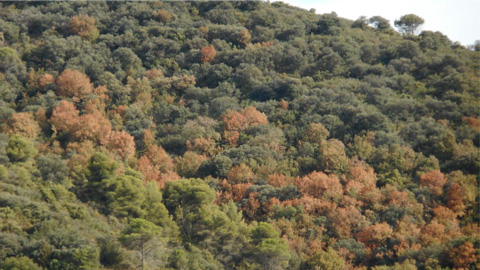Alert of unexpected mortality of forests following extreme climate phenomena

An international research team, with the involvement of UAB and CREAF researcher Jordi Martínez-Vilalta, alerts of the fact that forests which were not considered to be threatened by extreme climatic episodes are actually strongly affected by them. The study, led by the MIT, was recently published in the journal Annual Review of Plant Biology.
10/03/2022
In this review study, researchers analyse the main episodes of the past two decades of tree and forest mortality following climate extremes around the world. The results were surprising for the group of forest experts who conducted the study and emphasise the fact that a larger than expected mortality could occur in the next few years than that foreseen with the currently available scientific knowledge. Experts highlight that an improvement in data infrastructure can contribute to improving research in this field, as can early detections of these episodes of mortality.
In addition to the rise in temperatures, climate change also manifests itself with more frequent and more severe extreme meteorological phenomena. This is the case of droughts, such as those in the summers of 2018 and 2019, which destroyed German forests. Nevertheless, these extreme events and their effects are not new phenomena limited to Central Europe. The reports on tree mortality caused by climate factors and forest damage at large scale go back almost 50 years and have occurred around the world.
The analysis also took into account the knowledge of local forest experts. “What worries us most is that forests that were not considered to be at risk have been greatly affected”, says Henrik Hartmann, leader of the study at the Max Planck Institute for Biogeochemistry in Jena, Germany. The authors give detailed examples of the Amazons, Costa Rica and the United States of America, as well as of Spain, Australia and Germany. "All of these forest ecosystems were located in regions that before were considered impropable of suffering extreme climate episodes or contained ecosystems and tree species that were considered to tolerate extreme dryness and drought", explains Jordi Martínez-Vilalta, researcher at the Department of Animal Biology, Plant Biology and Ecology, and CREAF.
Difficulties in early detection
The authors also studied detection methods to be used in the early stages of mortality episodes caused by climate extremes. The results however were not very promising, given that remote sensing and vegetation models seem to have many limits. On the one hand, the satellites detect changes in forest coverage, in the treetops, but it does not capture the real extension of forest damage. On the other, vegetation models have always had difficulties in predicting tree death.
"We find ourselves in a situation in which the current knowledge of experts is reaching its limits, because recent climate events, as well as those expected to occur in the future, have never been seen before. Therefore, we cannot foresee how the forests will respond", affirms Ana Bastos, co-author of the study and also head of the group at the Institut Max Planck of Biogeochemistry, the centre leading this study. "We still do not have the tools that are needed to rapidly detect forest damage, analyse the causes and make predictions".
The mechanisms behind the death of forests could be identified by combining sets of already existing data and thus contributing to improving vegetation models. There are interesting sets of data, such as forest inventories or other monitoring activities, but the spatial and time resolution must be improved. At the moment, the dead trees and possible causes of mortality are rarely registered. Plus, the data collection intervals are too long and spatial density of the areas is too low.
One possible solution to fill in these data gaps is remote sensing. “But even in this case, spatial resolution is usually too low to detect the death of individual trees”, Bastos adds. To better understand the death of trees, it may be crucial to relate the conditions of an area with the behaviour of the species during extreme climate conditions. But there is still a long way to go before that can be done. “Easy and open access of data and improvements in forest studies coordinated at international level are key elements”, Hartmann says, “and in reality these are technically very easy objectives to reach today”. However, it is often administrative and legal obstacles that get in the way of achieving this.
In conclusion, Professor Craig Allen from New Mexico, USA, main author of the study and founding father of the world map on forest mortality, states that it is probable that more sudden and unexpected tree deaths occur, “soon, to a forest near us”.
Article: Henrik Hartmann et al. Climate Change Risks to Global Forest Health: Emergence of Unexpected Events of Elevated Tree Mortality Worldwide. Annual Review of Plant Biology 2022 73:1. https://doi.org/10.1146/annurev-arplant-102820-012804